Anne Reinarz Durham University
Re-cap
Re-cap
- Transport-layer services
- Multiplexing and demultiplexing
- Connectionless transport: UDP
- Principles of reliable data transfer
Re-cap: transport-layer services
- Logical communication between app processes running on different hosts
- Run in end systems
- TCP and UDP
- TCP: reliable, in-order delivery, connection setup congestion control …
- UDP: unreliable, unordered delivery, services not available, delay guarantees …
Re-cap:
Multiplexing and demultiplexing
- Multiplexing: handle data from multiple sockets, add transport header (later used for demultiplexing)
- Demultiplexing: use header info to deliver received segments to correct socke
Re-cap: reliable data transfer
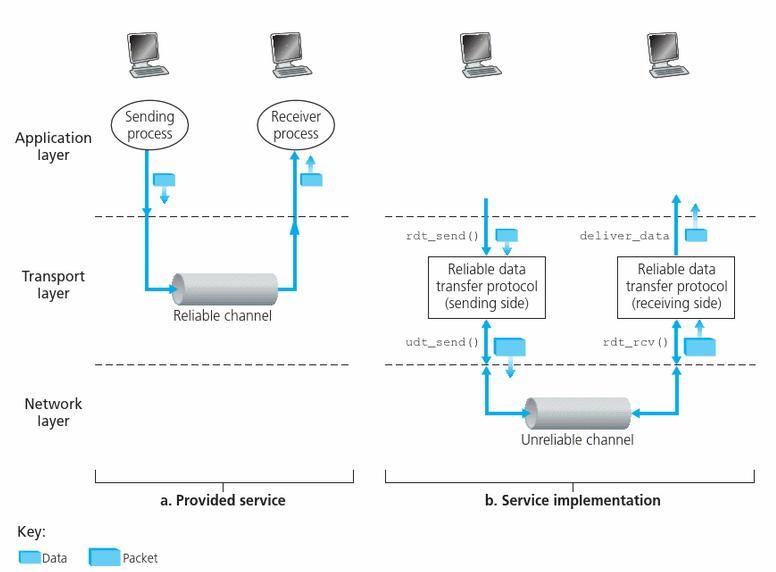 </img>
</img>
Outline
Reliable data transfer
We will:
- Incrementally develop sender, receiver sides of reliable data transfer protocol (rdt)
- Consider only unidirectional data transfer
- but control info will flow on both directions!
- Use finite state machines (FSM) to specify sender, receiver
rdt1.0:
reliable transfer over a reliable channel
- Underlying channel perfectly reliable
- No bit errors
- No loss of packets
- Separate FSMs for sender, receiver:
- Sender sends data into underlying channel
- Receiver reads data from underlying channel
rdt1.0
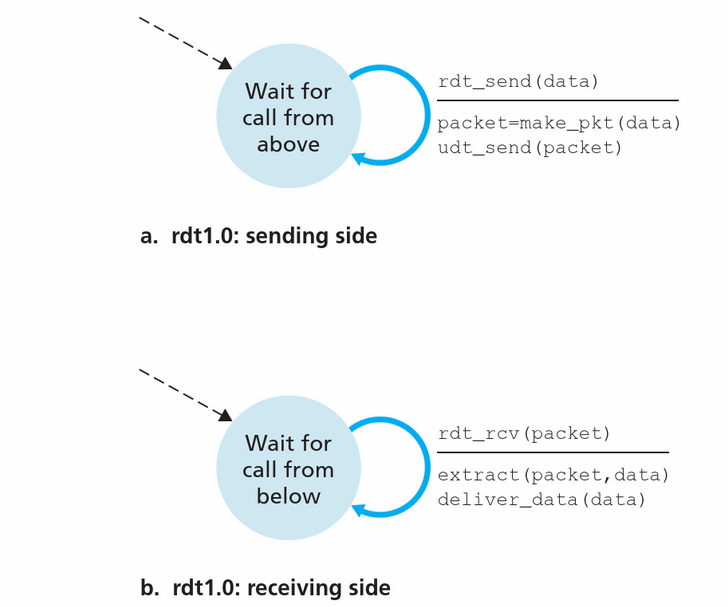 </img>
</img>
rdt1.0
- set up a sender
- Implements a reliable transfer
rdt_send - Uses an unreliable channel
udt_send
- Implements a reliable transfer
- set up a receiver
- Implements a reliable reciever
rdt_rcv
- Implements a reliable reciever
- For now we do not lose/corrupt any packets
rdt1.0
Go to: github
rdt2.0:
channel with bit errors
- Underlying channel may flip bits in packet
- use a checksum to detect bit errors
rdt2.0:
The question: how to recover from errors:
- Acknowledgements (ACKs): receiver explicitly tells sender that pkt received OK
- Negative acknowledgements (NAKs): receiver explicitly tells sender that pkt had errors
- Sender retransmits packet on receipt of NAK
ARQ
- Using ACKs & NAKs is known as ARQ (Automatic Repeat reQuest) protocols.
- Error detection. Sender embeds extra bits in packets
- Feedback. Receiver provide sender with feedback
- Retransmission. Retransmit erroneous packets
rdt2.0
New mechanisms in rdt2.0 (beyond rdt1.0):
- Error detection
- Feedback: control msgs (ACK (1), NAK (0)) from receiver to sender
rdt2.0
Two cases
- no error:
- deliver message
- send ACK
- error (corrupt message)
- send NAK
rdt2.0
 </img>
</img>
rdt2.0 has a fatal flaw
What happens if ACK/NAK corrupted?
- Sender doesn’t know what happened at receiver!
- Can’t just retransmit: possible duplicate
rdt2.0 has a fatal flaw
- Handling duplicates:
- Sender retransmits current pkt if ACK/NAK corrupted
- Sender adds sequence number to each pkt
- Receiver discards (doesn’t deliver up) duplicate pkt
</br>
#### Stop and wait
Sender sends one packet, then waits for receiver response
rdt 2.1 and rdt 2.2
- Add checksum to ACK and NAK
- Add sequence number to avoid duplication
rdt2.2: receiver
 </img>
</img>
rdt2.2: sender
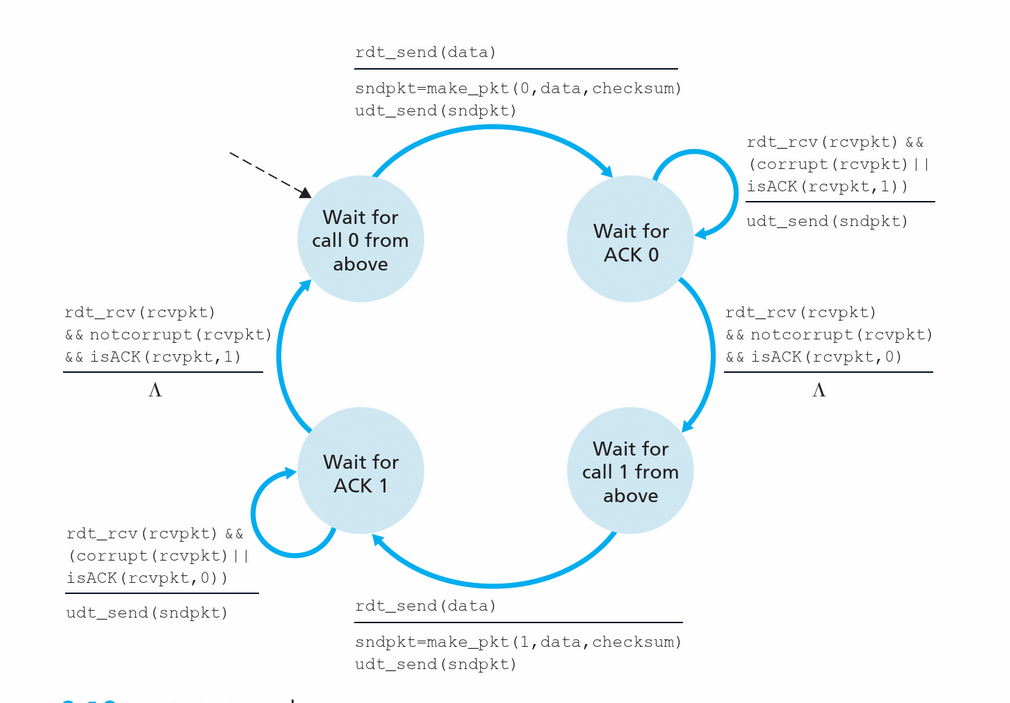 </img>
</img>
rdt3.0:
channels with errors and loss
New assumption:
- underlying channel can also lose packets (data, ACKs)
- Checksum, sequence #, ACKs, retransmissions will be of help… but not enough
rdt3.0:
channels with errors and loss
- Approach: sender waits “reasonable” amount of time for ACK
- Retransmits if no ACK received in this time
- If pkt (or ACK) just delayed (not lost):
- Retransmission will be duplicate, but seq. #’s already handles this
- Receiver must specify seq # of pkt being ACKed
- Requires countdown timer
rdt3.0: sender
 </img>
</img>
rdt3.0
 </img>
</img>
rdt3.0
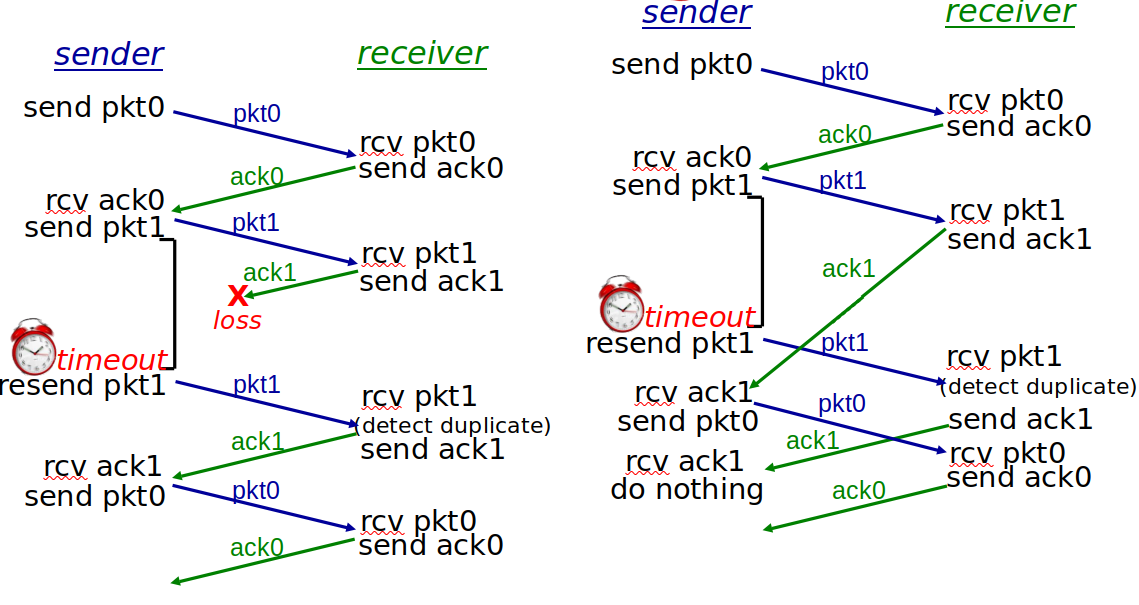 </img>
</img>
Pipelined protocols
 </img>
</img>
Pipelined protocols
- Range of sequence numbers must be increased.
- Unique sequence number, and there may be multiple, in-transit, unacknowledged packets.
- Multiple packet buffering at sender and/or receiver
- Sender buffers packets that have been transmitted but not yet acknowledged
- Buffering of correctly received packets
- Range of sequence numbers needed and the buffering requirements will depend on the manner in which a data transfer protocol responds to lost, corrupted, and overly delayed packets
Pipelined protocols
Two generic forms of pipelined protocols:
- go-Back-N,
- selective repeat
Go-back-N:
- Sender can send multiple packets without waiting for ACK.
- Sender can have up to N unacked packets in pipeline
- Receiver only sends cumulative ack
- Doesn’t ack packet if there’s a gap
- Sender has timer for oldest unacked packet
- when timer expires, retransmit all unacked packets
Selective Repeat:
- Sender can have up to N unacked packets in pipeline
- Receiver sends individual ack for each packet
- Sender maintains timer for each unacked packet
- When timer expires, retransmit only that unacked packet
Go-back-N in action
 </img>
</img>
Selective repeat
- Receiver individually acknowledges all correctly received pkts
- buffers pkts, as needed, for eventual in-order delivery to upper layer
- Sender only resends pkts for which ACK not received
- Sender timer for each unACKed pkt
- Sender window
- N consecutive seq #’s
- Limits seq #s of sent, unACKed pkts
Selective repeat
Sender
- Data from above:
- If next available seq # in window, send pkt
timeout(n):- Resend pkt n, restart timer
ACK(n) in [sendbase,sendbase+N]:- Mark pkt n as received
- If n smallest unACKed pkt, advance window base to next unACKed seq #
Selective repeat
Receiver
pkt n in [rcvbase, rcvbase+N-1]- Send ACK(n)
- Out-of-order: buffer
- In-order: deliver (also deliver buffered, in-order pkts), advance window to next not-yet-received pkt
pkt n in [rcvbase-N,rcvbase-1]- ACK(n)
- Otherwise:
- Ignore
Selective repeat
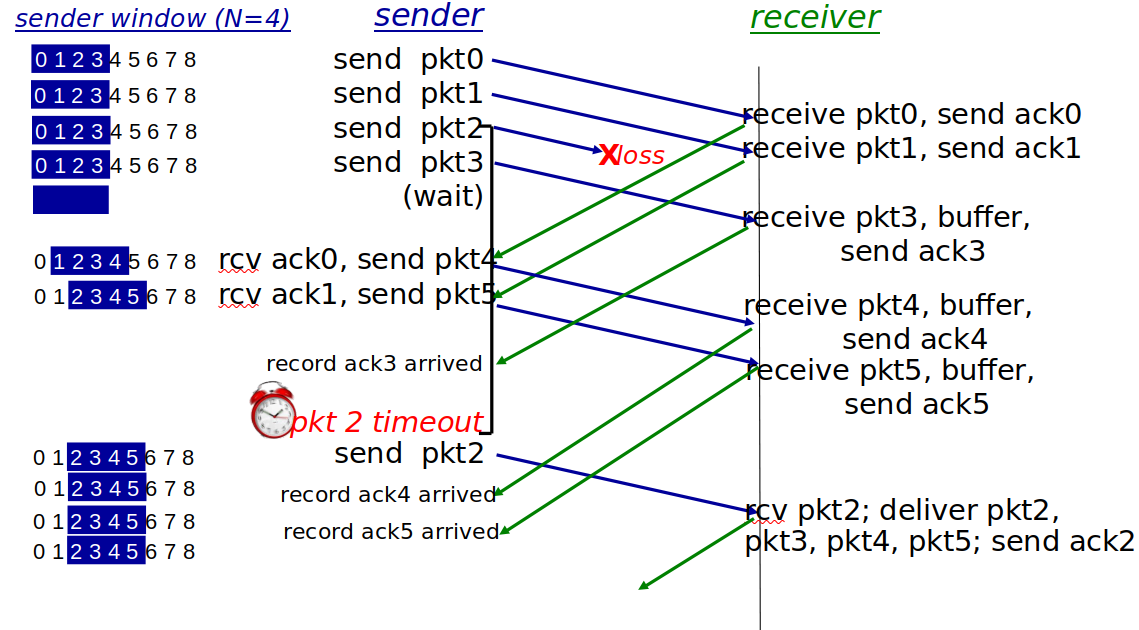 </img>
</img>
Selective repeat: dilemma
- Example:
- Finite range of seq #’s: 0, 1, 2, 3
- Window size=3
- Receiver sees no difference in two scenarios!
- Duplicate data accepted as new in (b)
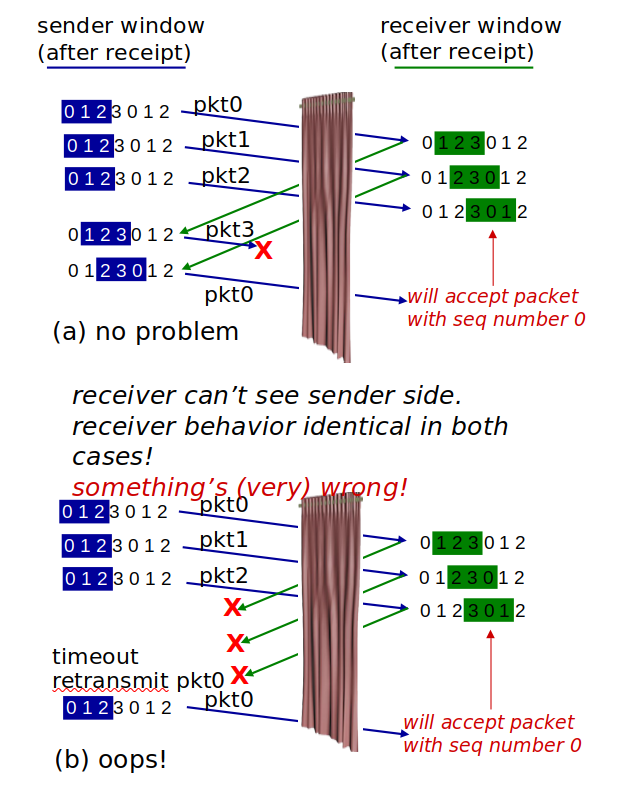 </img>
</img>
 </img>
</img>
Summary
- Principles of reliable data transfer
- Reliable data transfer protocols
- Pipeline protocol
- Go-Back-N protocol
- Selective repeat protocol
- Issues with protocols